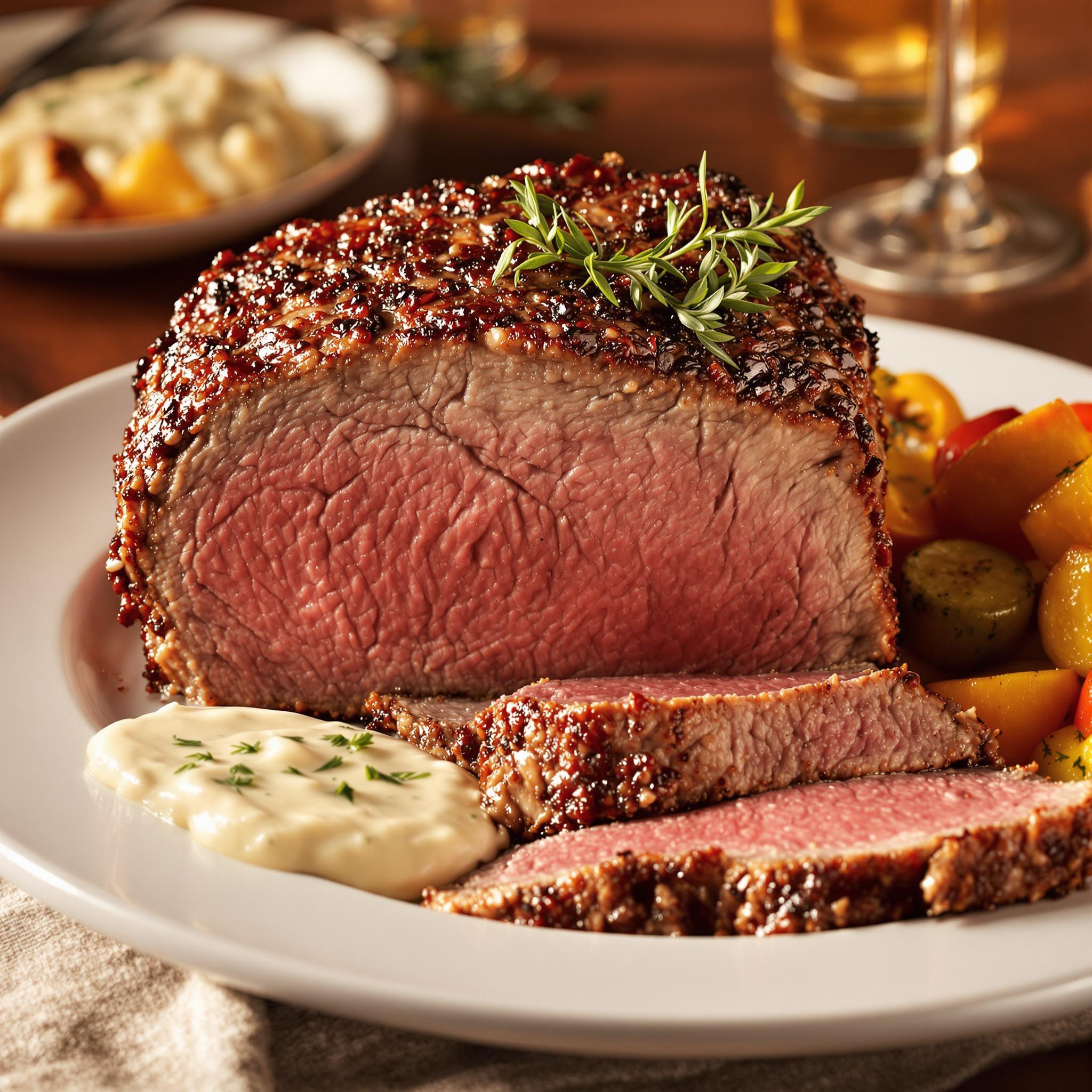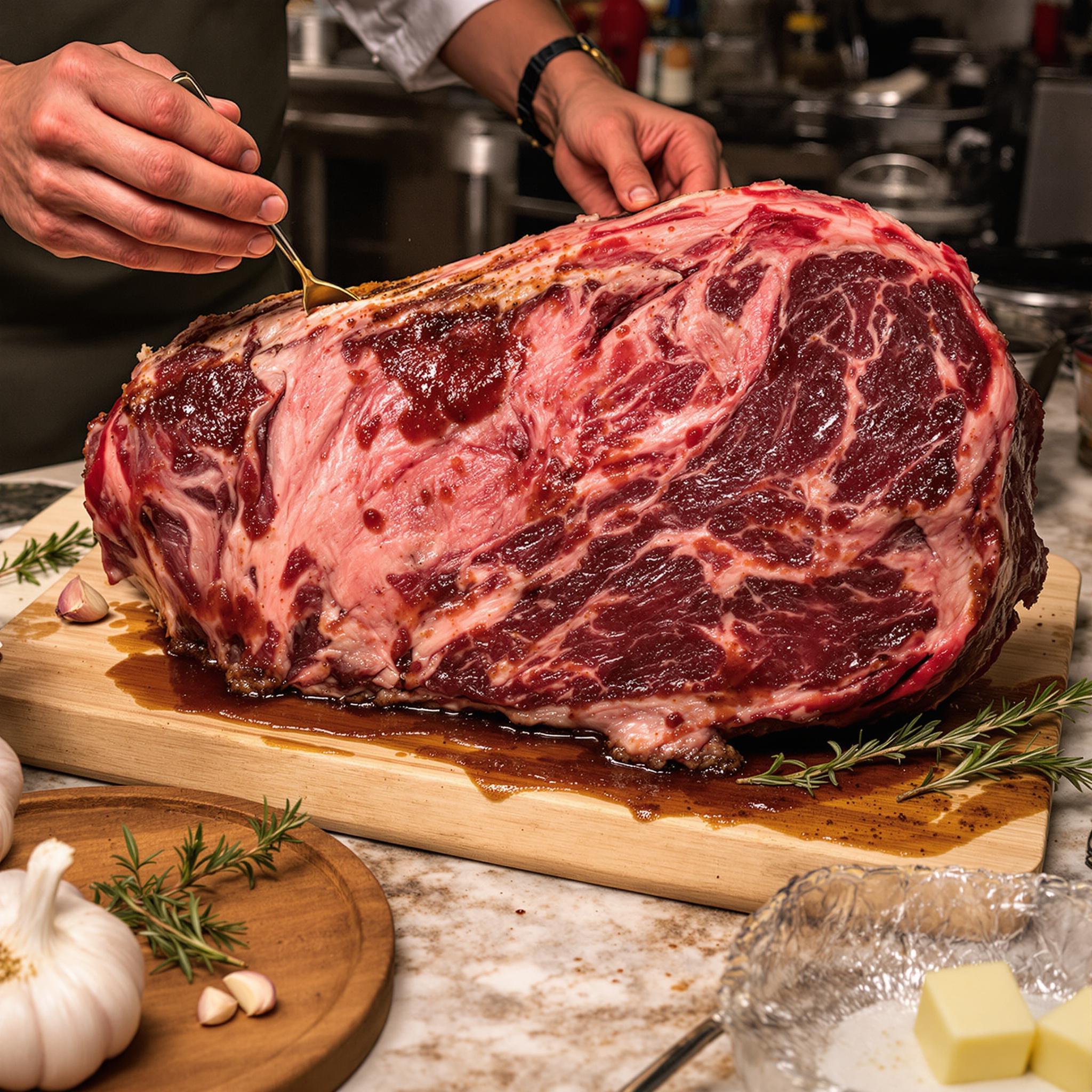Introduction to Chef John’s Perfect Prime Rib
There’s something magical about a perfectly cooked prime rib. The rich, savory aroma that fills the kitchen, the tender, juicy slices that practically melt in your mouth—this dish is pure indulgence. I remember the first time I made Chef John’s Perfect Prime Rib for my family during the holidays. It was a hit, and ever since, it has become my go-to recipe for special occasions. Whether you’re cooking for friends or hosting a cozy dinner, this prime rib recipe will leave everyone asking for seconds.
The History Behind Perfect Prime Rib
Prime rib, often called standing rib roast, has deep roots in traditional British cuisine. Historically, it was reserved for celebratory feasts due to its rich flavor and premium cut of meat. Over time, it gained popularity worldwide, becoming a staple for festive meals like Christmas and New Year’s Eve dinners. What makes Chef John’s version stand out is its modern twist on seasoning and roasting techniques, blending classic flavors with a touch of innovation. This perfect prime rib recipe honors tradition while offering an easy-to-follow method that guarantees success every time.
Why You’ll Love This Perfect Prime Rib Recipe
This prime rib recipe is a game-changer because it’s simple yet incredibly flavorful. The secret lies in the balance of herbs, garlic, and butter, which infuse the meat with layers of taste. Plus, the cooking method ensures a beautifully caramelized crust and a pink, juicy center. If you’ve ever been intimidated by making roast beef, fear not—this recipe simplifies the process without compromising quality. Every bite is a testament to why prime rib remains one of the most beloved cuts of meat.
Perfect Occasions to Prepare Chef John’s Perfect Prime Rib
This dish shines during holiday gatherings, birthday celebrations, or even intimate date nights. Imagine serving a glorious roast at your next dinner party—it’s sure to impress your guests! Whether it’s Thanksgiving, Christmas, or just a random Sunday when you feel like treating yourself, this perfect prime rib is always a good idea. Pair it with mashed potatoes, roasted vegetables, or a crisp salad for a complete meal.
Ingredients for Chef John’s Perfect Prime Rib
- 1 (3-bone) standing rib roast (about 7 pounds)
- 2 tablespoons kosher salt
- 1 tablespoon freshly ground black pepper
- 4 cloves garlic, minced
- 2 tablespoons fresh rosemary, chopped
- 2 tablespoons fresh thyme leaves
- 4 tablespoons unsalted butter, softened
Substitution Options for Flexibility
If you’re missing certain ingredients, don’t worry—you can still achieve delicious results. Swap fresh herbs with dried ones (reduce the quantity by half), use olive oil instead of butter, or omit the garlic if someone isn’t a fan. For those looking for leaner options, consider using grass-fed beef or trimming excess fat before seasoning. These substitutions keep the essence of the dish intact while catering to personal preferences.
Preparation Steps for Chef John’s Perfect Prime Rib
Step 1: Preheat and Prepare Your Roast
Start by preheating your oven to 500°F (260°C). While the oven heats up, pat the rib roast dry with paper towels. Removing surface moisture helps achieve that coveted golden crust. Season generously with kosher salt and freshly ground black pepper. Massage the seasonings into the meat, ensuring every inch is coated. Pro tip: Let the seasoned roast sit at room temperature for about 30 minutes to ensure even cooking.
Step 2: Create the Herb Butter Mixture
In a small bowl, mix minced garlic, chopped rosemary, thyme, and softened butter until well combined. This fragrant herb butter will elevate the flavor profile of your perfect prime rib. Spread the mixture evenly over the top and sides of the roast, pressing it gently so it adheres to the meat. As you work, take a moment to inhale the earthy aromas—it’s a preview of the deliciousness to come!
Step 3: Sear and Roast to Perfection
Place the seasoned rib roast bone-side down on a rack in a roasting pan. Slide it into the hot oven and let it sear for 15 minutes. This initial high heat locks in juices and creates a crispy exterior. After 15 minutes, reduce the oven temperature to 325°F (165°C) and continue roasting until the internal temperature reaches your desired doneness (120°F for rare, 130°F for medium-rare). Use a meat thermometer for accuracy. Pro tip: Tent the roast loosely with foil once it comes out of the oven to let it rest and redistribute its juices.
Chef’s Tip for Extra Flavor
To add an extra layer of depth, try basting the roast with pan drippings halfway through cooking. Not only does this keep the meat moist, but it also enhances the caramelization process. Another trick? Add a splash of red wine to the bottom of the roasting pan for a rich, savory jus that pairs beautifully with the finished dish.
Time Required for Chef John’s Perfect Prime Rib
- Prep Time: 15 minutes
- Cooking Time: Approximately 2 hours (depending on size)
- Resting Time: 20 minutes
- Total Time: Around 2 hours and 35 minutes
Nutritional Information
Per serving (based on 8 servings): Calories: 650 | Protein: 50g | Fat: 45g | Carbohydrates: 2g | Sodium: 900mg
An Interesting Curiosity About Prime Rib
Did you know that “prime rib” doesn’t necessarily mean the meat is USDA Prime grade? The term refers to the specific cut from the rib section of the cow. However, many restaurants and recipes opt for USDA Choice or higher grades for optimal marbling and tenderness. This fun fact adds a new appreciation for selecting quality cuts!
Necessary Tools for Making Perfect Prime Rib
- Roasting pan with rack
- Meat thermometer
- Sharp knife for carving
- Basting brush
- Paper towels for drying the meat
Storage Instructions for Leftover Prime Rib
Storing leftover prime rib properly ensures it stays fresh and retains its flavor. First, allow the meat to cool completely before refrigerating. Wrap individual slices tightly in plastic wrap or store them in an airtight container to prevent freezer burn. When reheating, avoid microwaving as it can dry out the meat. Instead, warm it gently in the oven with a bit of broth or au jus for added moisture.
If you plan to freeze the leftovers, divide them into portion-sized packages. Label each package with the date and consume within three months for best quality. Thaw frozen prime rib in the refrigerator overnight before reheating.
Finally, never underestimate the power of leftovers! Thinly sliced prime rib makes fantastic sandwiches, tacos, or salads. Get creative and enjoy every last bite of your perfect prime rib.
Tips and Tricks for Enhancing Your Prime Rib
- Use coarse sea salt for better adherence and texture.
- Sear the roast under the broiler for an intense crust if you prefer.
- Let the roast rest longer than you think—it’s worth the wait!
- Experiment with different herbs like sage or oregano for unique flavors.
Serving Suggestions for Chef John’s Perfect Prime Rib
Pair your prime rib with creamy horseradish sauce or a tangy chimichurri for dipping. Serve alongside classic sides like Yorkshire pudding, roasted Brussels sprouts, or buttery mashed potatoes. For a lighter option, toss together a vibrant arugula salad with shaved Parmesan and lemon vinaigrette.
Healthier Alternatives for Perfect Prime Rib
Here are six ways to adapt this recipe for health-conscious eaters:
- Lean Cut: Opt for a grass-fed or leaner cut of beef to reduce saturated fat content.
- Herb-Crusted Version: Increase the herb mixture and skip the butter for a lower-fat alternative.
- Smaller Portions: Slice thinly and serve smaller portions to control calorie intake.
- Vegan Twist: Substitute the roast with a plant-based protein like portobello mushrooms or jackfruit.
- Low-Sodium Option: Reduce the amount of salt and rely more on herbs and spices for flavor.
- Air Fryer Method: Cook smaller portions in an air fryer for a quicker, less oily result.
Common Mistakes to Avoid When Making Prime Rib
Mistake 1: Skipping the Resting Period
One of the biggest mistakes people make is slicing into the roast immediately after removing it from the oven. Doing so causes all the precious juices to escape, leaving the meat dry. Always let the roast rest for at least 20 minutes before carving. Pro tip: Tent it loosely with foil to retain warmth while resting.
Mistake 2: Overcooking the Meat
Prime rib is best enjoyed rare to medium-rare. Overcooking leads to tough, chewy meat that lacks juiciness. Invest in a reliable meat thermometer and remove the roast from the oven slightly below your target temperature, as it will continue to rise as it rests.
Mistake 3: Not Drying the Surface
Failing to pat the roast dry before seasoning prevents proper browning. Excess moisture creates steam rather than a crispy crust. Take the time to blot the surface thoroughly—it’s a small step that makes a big difference.
Frequently Asked Questions About Chef John’s Perfect Prime Rib
Can I Make Prime Rib Ahead of Time?
Absolutely! You can prepare the roast up to a day in advance, including seasoning it. Store it uncovered in the fridge to allow the surface to dry further, enhancing the crust when cooked.
How Do I Know When My Prime Rib Is Done?
Use a meat thermometer to check the internal temperature. Aim for 120°F for rare, 130°F for medium-rare, and adjust accordingly based on your preference.
What Can I Do With Leftover Au Jus?
Leftover au jus is perfect for drizzling over sandwiches, mixing into gravy, or freezing for future recipes. It adds incredible depth to soups and stews too!
Is Prime Rib Gluten-Free?
Yes, prime rib is naturally gluten-free. Just ensure any additional sauces or seasonings you use are free from gluten-containing ingredients.
Can I Cook Prime Rib in a Slow Cooker?
While slow cookers aren’t ideal for achieving a crispy crust, they can still yield tender, flavorful results. Brown the roast in a skillet first, then transfer it to the slow cooker for low-and-slow cooking.
Should I Cover the Roast While Cooking?
No, covering the roast traps steam, preventing the formation of a crispy crust. Leave it uncovered for optimal browning and texture.
What Are Some Good Side Dishes for Prime Rib?
Classic pairings include mashed potatoes, roasted root vegetables, green bean casserole, and Caesar salad. Don’t forget a decadent dessert like chocolate mousse to round out the meal.
Can I Freeze Prime Rib?
Yes, wrap leftover prime rib tightly in plastic wrap and aluminum foil before freezing. Consume within three months for the best quality.
How Do I Reheat Prime Rib Without Drying It Out?
Reheat slices in a low oven (around 250°F) with a splash of broth or au jus to keep them moist. Alternatively, warm them gently in a skillet with butter.
What’s the Difference Between Prime Rib and Ribeye?
Prime rib refers to the whole roast, typically cooked slowly, while ribeye is a steak cut from the same area. Both are incredibly flavorful, but their preparation methods differ significantly.
Conclusion
Chef John’s Perfect Prime Rib is more than just a recipe—it’s an experience. From its rich history to its unmatched flavor, this dish deserves a spot on your table for special occasions. With careful attention to detail and these expert tips, you’ll master the art of cooking prime rib in no time. So grab your apron, invite some loved ones over, and savor the joy of sharing this culinary masterpiece. Happy cooking!



